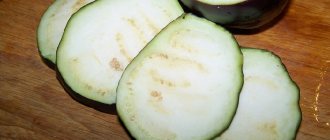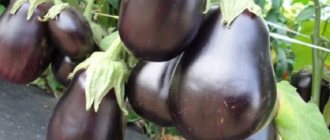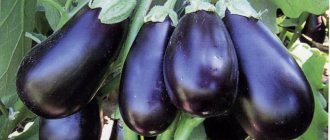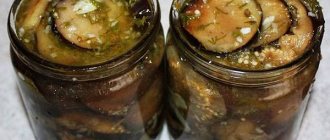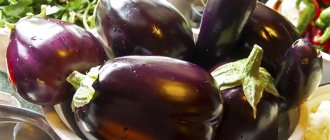- Description and characteristics of eggplant Giselle
- Growing Eggplant
- Planting eggplant seedlings
- Video: obtaining eggplant seedlings
- Caring for eggplant plantings
- Reviews of eggplant Giselle
Next to representatives of the numerous nightshade family, eggplant looked more like a stepchild against the background of favorites: potatoes and tomatoes. Even peppers felt more comfortable in our plots until eggplant hybrids appeared, grown in protected soil. One of these varieties is Giselle, an eggplant that delights summer residents from Bryansk to Yakutia
Eggplant Giselle: photo, description, reviews, characteristics of the variety.
Description and characteristics of eggplant Giselle
The Giselle variety has been included in the State Register since 2001 for cultivation in the third light zone.
On a note! To get a high-quality harvest of vegetable crops in closed ground, you need to know with what intensity the sun shines on the site. Scientists have discovered that in addition to the duration and intensity of illumination, the spectral composition of solar radiation also matters. The radiation absorbed by plant chlorophyll is called photosynthetic active radiation, PAR. The entire territory of Russia is divided into light zones according to increasing natural PAR. There are only seven of them, and the largest number of regions, from the Kaliningrad to the Tyumen region and the Republic of Khakassia, are included in the third light zone
Eggplant Giselle is a large, medium-spreading plant, growing up to almost two meters. The stem is slightly spiny, with large green pubescent leaves. In open ground, Giselle does not grow to such a size. The flowers are soft lilac, reminiscent of potato flowers, but larger in size. Usually 45 days after flowering, eggplants ripen.
Eggplant Giselle is an early ripening variety. After the first friendly shoots, the eggplants ripen in just 107–117 days. The shape of the fruit is cylindrical, the color is intense purple to black. The surface is smooth and shiny. The length of the fruit at the stage of commercial maturity is 25–30 cm. The diameter is usually 7 cm, weight is in the range of 300–400 g. The pulp of ripe fruits is white, tender, without bitterness. The seeds are small. Harvested eggplants can remain marketable and taste great for 3-4 weeks.
The soft lilac flowers of eggplant are larger than potato flowers.
Giselle fruits can reach 30 cm in length and weigh 400 g.
On a note! The yield of Giselle eggplant in greenhouse conditions reaches 11.6–17.6 kg/m2; when grown in open ground, only 7–9 kg/m2 are harvested
Growing Eggplant
Giselle is not a variety in the usual sense, but a first-generation hybrid (the seed package has the designation F1).
This means that there is no point in trying to save a couple of successful torpedo fruits for seed. According to all the laws of genetics, the offspring obtained from a hybrid in the first generation will split the parental properties, that is, it is impossible to predict which eggplants will grow from these seeds.
It’s easier to trust the professionals, buy seeds, sow in insulated cups, get your own seedlings, plant them in a greenhouse or under film covers and wait for an early harvest of high-quality eggplants.
Planting eggplant seedlings
Seeds for seedlings are sown in mid-March. Before sowing, they can be soaked in some kind of growth stimulant. Recommended products: Epin , Zircon , Energen and others. The seeds are wrapped in gauze soaked in the solution.
After the roots hatch, the seeds are planted in seedling cups or cassettes, not deeper than 1 cm. As soil, you can use a ready-made soil mixture for seedlings or more modern mixtures, for example, coconut briquettes
After planting the seeds, the soil is sprayed with water rather than watered so that the seeds do not bury deep. Cover the cups with plastic film to retain moisture and put them in a warm place until germination. With the appearance of the first sprouts, the cups are transferred to a windowsill or other lighted and warm place. It is customary to additionally connect artificial light sources so that the seedlings do not stretch.
Video: obtaining eggplant seedlings
On a note! The need to sow seeds in separate seedling cups is due to the fact that eggplants do not respond well to picking and replanting. And from separate cups, seedlings can be planted into the soil without damaging the plant.
A week and a half before planting, they begin to harden the sprouts: open the windows, take the cassettes and seedling cups out onto the balcony. Seedlings are planted in late May or early June, when the plants have already formed 6-7 true leaves. Eggplants do not form additional roots when planted deep.
Planting eggplants is carried out according to the following algorithm:
- The soil is loosened in advance and rows are formed.
- When planting, the stems are buried to the level of the cotyledons.
- Eggplants are planted at a distance of 30–35 cm, and up to 60–65 cm are left between rows. Optimal planting density: 4–5 plants per 1 m2. A more crowded arrangement is possible in open ground, but in protected ground conditions it will lead to a decrease in yield.
From individual cups, seedlings are planted into the soil without stressing the plants.
Leave 30–35 cm between eggplant plants in a row.
Good predecessors for eggplant are representatives of the legume family, pumpkin and green crops. Root vegetables include beets and carrots. Potatoes are not suitable as a predecessor, since, being representatives of the same family, they and eggplant have common pests and similar soil requirements.
Collection and storage
The hybrid variety “Giselle” is early ripening. Eggplants begin to ripen a month and a half after the bush blooms. If you count from the moment the sprouts appear, then this is approximately 118 days. Ripe eggplants should be picked before frost arrives. If there are green vegetables on the Giselle bushes by autumn, it is recommended to carefully dig them up and put them away, for example, in a greenhouse, and after watering, wait 14 to 21 days, during which time the eggplant will reach technical maturity. Harvested eggplants in a cool place can last for 3 or 4 weeks, remaining beautiful, presentable in appearance and tasty.
Since the shelf life of eggplants is short, special conditions should be provided for them to extend their shelf life, as well as to preserve their taste and beneficial properties. For storing the crop, a cool, shaded room with a temperature of about 7 or 10 positive degrees and a humidity of about 85 or 90 percent is selected. And if the temperature in the room is no more than one or two positive degrees, and the humidity level is about 80 percent, then the eggplants will last for about a month. A prerequisite for this will be darkness. Under the influence of light, overripe fruits produce a lot of corned beef, this spoils the eggplants and their taste changes.
Tip: Heat treatment of vegetables minimizes corned beef.
Unripe Giselle can be placed in the lower compartment of the refrigerator. There should be no damage to vegetables. If you put eggplants on the balcony, be sure to pack them in a dark bag made of polyethylene or high-density paper, or cover them with a cloth. If a basement or cellar is used to store the crop, then the zucchini will need to be laid out in boxes, sprinkled with grains of wood ash.
Caring for eggplant plantings
It is recommended to water the eggplant bushes with warm water in the first half of the day, while avoiding getting water on the leaves. When caring for plantings, it is important not to forget about fertilizing. Eggplant responds gratefully to the application of organic fertilizers (slurry diluted in a ratio of 1:10) and to foliar feeding with complex fertilizers (10 g of Kemira Lux per 10 liters of water)
Greenhouses must be periodically ventilated, the soil loosened and weeds removed. While the plants are still young, weeding is carried out regularly; subsequently, almost no weeds grow under tall eggplant bushes
On a note! When grown in protected soil, it becomes necessary to support eggplant plants; to do this, they are tied to a support. In open ground, the stem of the shoot is thicker and the bushes do not grow so large
Giselle eggplant bushes do not need to be formed, but it is better to remove the first stepsons, as well as yellowing leaves during the entire growing season.
Intensive harvesting stimulates flowering, so you should not leave the fruits on the bush after ripening.
On a note! By the way, the smallest scraped fruits can be used for pickling or making jam that is original in appearance and extremely tasty. This is such a rare delicacy that a separate article can be devoted to it.
The last, smallest eggplant fruits are used for jam.
Landing
Eggplant Giselle F1 is sown from the third ten days of January (in the southern regions). In the temperate zone, seedling cultivation begins in February-March. In the North, seeds are sown from the second half of March. Bushes with 7–8 leaves are transplanted to a permanent place when the ground warms up to 14–16 degrees.
Farmers advise treating seed material with a stimulant. The duration of soaking the seeds in the solution is 5–7 hours. Suitable products: Epin, Agate, Bioglobin. When small seedlings appear, the seeds are planted in containers or containers of 250–300 ml. The soil mixture is ordered from an agricultural store or made up of turf, compost, or humus.
The seeds are sown 1.5 cm deep, the ground is moistened in advance with warm water. The surface is lightly compacted from above. Before emergence, the boxes are covered with film. To illuminate the seedlings, photo lamps and fluorescent lamps are connected.
At the 2-leaf stage, eggplants are fed with urea or nitroammophos (the proportion for dilution is 15–20 g per 10 l). The second feeding is carried out with a complex product: Kemira-lux or Gumi (proportion - 25-30 g of the drug is diluted in 10 liters of water).
In the phase of 8–9 leaves, the bushes are transplanted to stationary beds. Young plants are pre-hardened for two weeks. The optimal temperature when performing the procedure is 12–15 degrees.
The beds are dug up in the fall, and green manure crops (phacelia, oats, rye, lupine) are sown. In the spring, the area is dug up and the green mass is buried under a layer of soil. Add rotted compost (5–7 kg per 1 sq. m), superphosphate (40 g per 1 sq. m). Marigolds, calendula, greens, salad crops, and carrots are planted next to eggplants.
Plantings should not be thickened. For 1 sq. m plant 3-4 bushes. The spacing between plants is 35 cm in a row, 70 cm between rows.
Reviews of eggplant Giselle
aee0412 Russia, Cherepovets
Review: Eggplant seeds Giselle F1 Russian vegetable garden Advantages: Cold-resistant. For long-term storage. Good seed germination. High yield. Taste without bitterness. Disadvantages: Like all plants, it requires regular feeding and watering. I didn't see any others. The pulp is white, dense, the seeds are medium-sized. Taste: pronounced eggplant flavor, without bitterness, with a pleasant pungency. This year I planted Giselle eggplants again.
Perchinka, Dacha 200 km from Krasnoyarsk
Quote (Lenych @ 20.1.2016, 15:15) so I bought it for such reviews! so what if they are long? into blanks - what's the difference? and for the grill - a plump Epic, but Galine and Giselle are also highly praised. Nobody has any experience? I planted Giselle, which tastes good, but there were only two or three fruits all summer, probably it needs to be placed in a greenhouse or under film covers.
Tagetes. Address: Veliky Novgorod
According to the reviews of forum members, I will choose Almaz, Mishutka or Giselle By the way, on October 1st they took off the last buckles and... uprooted “Giselle” :(! She objected, showed numerous flowers, but we mustered our will into a fist and - amen :|: ! She’ll tie it anyway, but will not have time to grow. Total: over the summer (from July to October) from 10 plants - 43 kg of bucks. How it behaves in the OG, I have no idea, but in the greenhouse - :super.
Giselle is a high-yielding, early-ripening eggplant variety that is highly resistant to temperature changes. By following all the rules for caring for this plant, all summer long you will be able to receive sweet and smooth fruits of the Giselle variety, which can be fried, stewed or baked directly in the peel, without fear of bitterness, and enjoy a clean, rich, slightly tart taste
Did you like the article? Share with your friends and like!
Facebook Twitter VKontakte
NEWS DELIVERY BY MAIL IS CONVENIENT
When you subscribe, you will receive an email about new articles posted on the site over the past two weeks.
Growing and care
When cultivating Giselle F1 eggplants, follow the standard rules of agricultural technology:
- watering - once every 3-4 days;
- feeding - every 2-3 weeks;
- protection from pests and infectious agents;
- surface treatment of beds.
To increase productivity before flowering, mineral-organic compositions are used, then phosphorus-potassium solutions are added. Water the bushes with settled water, the moisture norm for 1 bush is from 3 to 6 liters. Avoid high humidity, which increases the risk of rot.
Compositions of solutions for feeding eggplants:
| Phase for application | What is included in the composition | Amount per 10 liters of solution |
| With the beginning of flowering | Ammophoska (nitroammophoska) Wood ash Mullein Nettle infusion | 30 g 1 tbsp. l. 1 l 1 l |
| Active fruiting | Urea Superphosphate Potassium chloride | 60–75 g 60–75 g 20–25 g |
If there is a high level of humidity in the area (rainy season), ash powder is scattered over the surface - 1-2 cups per 1 square meter. m. The optimal humidity in the greenhouse is up to 70%.
The fruits are removed along with the bed. The frequency of cleaning is once every 7–8 days.


